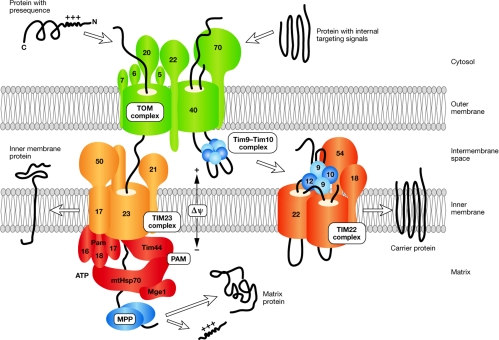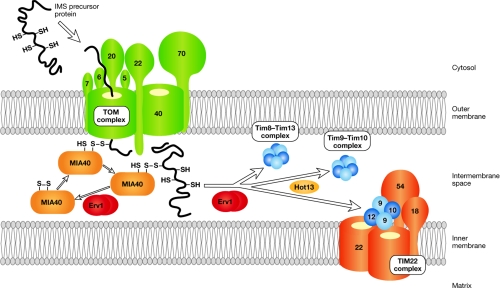Abstract
Mitochondria import hundreds of different precursor proteins from the cytosol. More than 50% of mitochondrial proteins do not use the classical import pathway that is guided by amino-terminal presequences, but instead contain different types of internal targeting signals. Recent studies have revealed an unexpected complexity of the mitochondrial protein import machinery and have led to the discovery of new transport pathways. Here, we review the versatility of mitochondrial protein import and its connection to mitochondrial morphology, redox regulation and energetics.
Keywords: MIA, PAM, SAM, TIM, TOM
Introduction
Mitochondria are dynamic organelles that have a crucial role in cellular energy conversion, metabolism of amino acids, lipids and iron–sulphur clusters, and the regulation of apoptosis. It has been assessed that the mitochondria of baker's yeast contain approximately 1,000 proteins (Sickmann et al, 2003; Prokisch et al, 2004; Reinders et al, 2006). Only few of them are encoded by the mitochondrial genome, whereas 99% of mitochondrial proteins are encoded by nuclear genes and are synthesized as precursors on cytosolic ribosomes.
The cytosolic precursor proteins are recognized by receptors on the mitochondrial surface and are imported by the general entry gate, the preprotein translocase of the outer membrane (TOM complex; Fig 1). Recent studies have revealed a surprising variety of import mechanisms and machineries. At least four classes of precursor proteins exist that contain distinct targeting signals and are directed to different import routes. Here, we review the rapid development of the mitochondrial import field and its connection to areas that so far were assumed not to be directly related to protein import, including redox regulation, respiratory chain and mitochondrial morphology.
Figure 1.
Two main protein import pathways of mitochondria. Presequences direct proteins through the TOM complex, TIM23 complex and motor PAM to the matrix; the mitochondrial processing peptidase (MPP) removes the presequences. Cleavable inner membrane proteins are laterally released from the TIM23 complex. Carrier precursors with internal targeting signals are recognized by the receptor Tom70, and translocated by the TOM complex and the Tim9–Tim10 chaperone of the intermembrane space. The TIM22 complex promotes insertion of carrier proteins into the inner membrane. MtHsp70, matrix heat shock protein 70; PAM, presequence translocase-associated motor; TIM, translocase of the inner membrane; TOM, translocase of the outer membrane.
Mitochondrial proteome and new import components
In 2001, the mitochondrial import field seemed to have reached a mature state in which two main protein import pathways—the presequence pathway and the carrier pathway (Fig 1)—were believed to be well characterized. It was assumed that most of the critical import components had already been identified. A first surprise came in 2002 when a new component of the presequence translocase of the inner membrane (TIM23 complex) was identified and shown to be essential for protein import and cell viability (Geissler et al, 2002; Yamamoto et al, 2002). Was this just one component that had been overlooked, or the tip of an iceberg? The latter assumption turned out to be correct; not only were numerous new components of the presequence pathway identified, but also two new import pathways, the sorting and assembly machinery (SAM) of the outer membrane and the machinery for intermembrane space import and assembly (MIA; Table 1).
Table 1.
Components of the mitochondrial protein import machinery*
| Name | Systematic yeast name | Aliases | Function/description |
|---|---|---|---|
| Translocase of the outer membrane (TOM complex) | |||
| Tom70 | YNL121C | Mas70, Mom72, Omp1 | Receptor for non-cleavable precursor proteins |
| Tom40 | YMR203W | Isp42, Mom38 | General import pore |
| Tom22 | YNL131W | Mas17, Mas22, Mom22 | Central receptor |
| Tom20 | YGR082W | Mas20, Mom19, Pom23, Rir16 | Presequence receptor |
| Tom7 | YNL070W | Mom7, Yok22 | Stability/assembly factor |
| Tom6 | YOR045W | Isp6, Mom8b | Stability/assembly factor |
| Tom5 | YPR133W-A | Mom8a | Preprotein transfer and assembly factor |
| Sorting and assembly machinery (SAM) of the outer membrane | |||
| Sam50 | YNL026W | Omp85, Tob55 | Conserved core component of SAM complex |
| Sam37 | YMR060C | Mas37, Pet3027, Tom37 | Subunit of SAM complex |
| Sam35 | YHR083W | Fmp20, Tob38, Tom38 | Subunit of SAM complex |
| Mdm10 | YAL010C | Fun37 | Cooperates with SAM complex and Mdm12/Mmm1 |
| Mdm12 | YOL009C | – | Component of β-barrel assembly pathway |
| Mmm1 | YLL006W | Yme6 | Component of β-barrel assembly pathway |
| Mim1 | YOL026C | Tom13 | Involved in outer membrane protein biogenesis |
| Chaperones of intermembrane space (small TIM proteins) | |||
| Tim13 | YGR181W | – | Subunit of Tim8–Tim13 chaperone complex |
| Tim10 | YHR005C-A | Mrs11 | Subunit of Tim9–Tim10 chaperone complex and TIM22 complex |
| Tim9 | YEL020W-A | – | Subunit of Tim9–Tim10 chaperone complex and TIM22 complex |
| Tim8 | YJR135W-A | DDP1 | Subunit of Tim8–Tim13 chaperone complex |
| Mitochondrial intermembrane space import and assembly machinery (MIA) | |||
| Mia40 | YKL195W | Tim40, Fmp15 | Intermembrane space receptor for small cysteine-containing precursor proteins |
| Erv1 | YGR029W | – | Sulphydryl oxidase, cooperates with Mia40 |
| Hot13 | YKL084W | – | Assembly factor |
| Carrier translocase of inner membrane (TIM22 complex) | |||
| Tim54 | YJL054W | – | Subunit of TIM22 complex |
| Tim22 | YDL217C | – | Central, channel-forming subunit of TIM22 complex |
| Tim18 | YOR297C | – | Subunit of TIM22 complex |
| Tim12 | YBR091C | Mrs5 | Peripheral subunit of TIM22 complex, associates with Tim9 and Tim10 |
| Presequence translocase of inner membrane (TIM23 complex) | |||
| Tim50 | YPL063W | – | Intermembrane space-exposed subunit of TIM23 complex |
| Tim23 | YNR017W | Mas6, Mim23, Mpi3 | Channel-forming subunit of TIM23 complex |
| Tim21 | YGR033C | Fmp17 | Interacts with TOM complex and respiratory chain |
| Tim17 | YJL143W | Mim17, Mpi2, Sms1 | Regulator of Tim23 channel, sorting of preproteins |
| Presequence translocase-associated motor (PAM) | |||
| mtHsp70 | YJR045C | Ens1, Ssc1 | Molecular chaperone, core of PAM |
| Tim44 | YIL022W | Isp45, Mim44, Mpi1 | Binding partner of mtHsp70 at inner membrane |
| Pam18 | YLR008C | Tim14 | J-protein at inner membrane, complex with Pam16 |
| Pam17 | YKR065C | Fmp18 | Organizer of Pam18–Pam16 module |
| Pam16 | YJL104W | Mia1, Tim16 | J-related regulator of Pam18 |
| Mge1 | YOR232W | mtGrpE, Yge1 | Nucleotide exchange factor |
*Processing enzymes are not listed.
There are three main reasons why many new import components were identified. First, mild protocols for the purification of translocase complexes were developed (Geissler et al, 2002); thus, loosely associated subunits were co-purified and identified by mass spectrometry. Second, native gel systems for monitoring import intermediates were established, leading to the identification of new import stages of precursor proteins (Model et al, 2001; Wiedemann et al, 2003; Chacinska et al, 2004). This technology, in combination with the systematic analysis of yeast mutants, drove the discovery of new protein sorting machineries. Third, a comprehensive proteomic analysis revealed a large number of new mitochondrial proteins, including proteins of unknown function that are essential for cell viability (Sickmann et al, 2003; Prokisch et al, 2004; Reinders et al, 2006). The characterization of these essential proteins yielded numerous new import components.
Thus, a combination of proteomics, yeast genetics and native techniques for protein analysis was responsible for the boost in identification of new import components, and greatly expanded our view of mitochondrial import, leading to the characterization of four mitochondrial import pathways that will be discussed in the following paragraphs.
Presequence pathway to matrix and inner membrane
Most mitochondrial matrix proteins are synthesized in the cytosol with a characteristic amino-terminal presequence that forms a positively charged amphipathic α-helix. Presequences direct the proteins to the mitochondria and across both outer and inner membranes into the matrix where they are usually cleaved off by the mitochondrial processing peptidase (MPP; Fig 1).
On recognition by the receptors Tom20 and Tom22, the preproteins are translocated through the channel formed by Tom40 (Abe et al, 2000; Becker et al, 2005). It has long been debated whether and how the TOM and TIM23 complexes cooperate. Two recently identified proteins with hydrophilic domains in the intermembrane space, Tim50 and Tim21, were found to participate in preprotein transfer from TOM to TIM23 (Geissler et al, 2002; Yamamoto et al, 2002; Chacinska et al, 2005). Tim50 binds to the protein emerging at the trans side of the TOM channel and promotes binding of the presequence to the intermembrane space domain of Tom22. Tim21 connects TOM and TIM complexes by direct but transient binding to Tom22. Remarkably, it was shown that Tim21 competes with presequences for binding to Tom22 (Chacinska et al, 2005; Albrecht et al, 2006). Therefore, as the Tim50-stimulated binding of preproteins to Tom22 does not require Tim21 (Chacinska et al, 2005), we propose that Tim21 functions in the subsequent step of preprotein release from Tom22. Owing to its competition with presequences, Tim21 binding to Tom22 is thought to promote release of the preprotein.
Two energy sources drive preprotein translocation across the inner membrane—the electrochemical potential gradient and ATP. The membrane potential Δψ activates the channel-forming protein Tim23 and exerts an electrophoretic effect on the positively charged presequences (Truscott et al, 2001; Krayl et al, 2007). In addition to its role in cooperation with the TOM machinery, Tim50 has an essential function in regulating the inner membrane barrier. The electrochemical proton gradient generated by the respiratory chain of the inner membrane is crucial for the synthesis of the bulk of cellular ATP by the mitochondrial ATP synthase. Therefore, the inner membrane forms a highly specific barrier to prevent an unspecific leakage of ions. However, Tim23 forms a large channel that can transport precursor polypeptides in α-helical conformation. In fact, reconstitution experiments with purified Tim23 also showed that the channel was mainly in an open state in the absence of preproteins (Truscott et al, 2001). As an isolated mitochondrion contains approximately 300 Tim23 molecules, the presence of this channel in an open state would be deleterious to mitochondria by causing a breakdown of the proton gradient. A systematic analysis of the partner proteins of Tim23 revealed that the intermembrane space domain of Tim50 binds to Tim23 and promotes closing of the channel in the absence of preproteins, thus preventing a leakage of ions (Meinecke et al, 2006). When a preprotein arrives in the intermembrane space, Tim50 interacts with the preprotein, leading to a conformational change and opening of the channel.
ATP drives the central component of the presequence translocase-associated motor (PAM), the matrix heat shock protein 70 (mtHsp70). MtHsp70 binds to the unfolded preprotein in transit and—in cooperation with membrane-associated co-chaperones—drives the preprotein into the matrix. There are two current hypotheses for the mechanism of action of mtHsp70: trapping of preproteins by a Brownian ratchet that prevents back-sliding of the polypeptide chain, or active pulling (force-generation) by a motor. Experimental and theoretical evidence for both models has been presented and, in addition, a contribution of the membrane potential to the import-driving force has been discussed (Geissler et al, 2001; Okamoto et al, 2002; Shariff et al, 2004; D'Silva et al, 2005; Sato et al, 2005; Krayl et al, 2007). Both models agree that mtHsp70 binds to the inner membrane through Tim44 in an ATP-regulated manner, and not only promotes translocation of the preproteins into the matrix, but is also required for driving the unfolding of preprotein domains that are still located on the cytosolic side. The identification of three new membrane-bound motor components—Pam16, Pam17 and Pam18—revealed that the import motor consists of three modules: a nucleotide-sensitive mtHsp70–Tim44 complex, a regulatory Pam18–Pam16 complex and Pam17 (Li et al, 2004; D'Silva et al, 2005; van der Laan et al, 2005; Mokranjac et al, 2006). Pam18 is a DNAJ-like protein that stimulates the ATPase activity of mtHsp70, whereas Pam16 controls the activity of Pam18; Pam17 is needed for the assembly of the Pam18—Pam16 module. These findings suggest that the import motor is a complex machinery containing four membrane-bound co-chaperones, Tim44 and the three Pam proteins, which associate with the TIM23 complex to coordinate the function of mtHsp70 exactly where the preprotein emerges from the Tim23 channel. A mutant form of mtHsp70—which is impaired in binding to the inner membrane, but still able to bind to substrate—is competent in the trapping of unfolded preproteins and driving their import, whereas preproteins with tightly folded domains cannot be imported (Geissler et al, 2001). We suggest that this mtHsp70 is able to perform a basic trapping function, whereas the generation of force that unfolds preprotein domains requires an efficient cooperation with the membrane-bound co-chaperones. Although further experimental studies are needed to clarify the molecular mechanism of the mitochondrial import motor, it is tempting to speculate that the integration of mtHsp70 into the multi-subunit PAM machinery leads to a multi-step motor that performs both suggested functions, that is, the trapping and pulling of preproteins.
Several integral inner membrane proteins are synthesized with an N-terminal presequence followed by a hydrophobic sorting signal. The sorting signal arrests translocation in the inner membrane and induces lateral release of the protein into the lipid phase (Fig 1). Some intermembrane space proteins are also imported through the presequence route. Those preproteins are cleaved in two steps, by MPP and by inner membrane proteases that remove the sorting signal. A form of the TIM23 complex without mtHsp70 is responsible for the sorting of preproteins into the inner membrane, a process that involves Tim17 and Tim21 (Chacinska et al, 2005). Tim17 promotes lateral release from the Tim23 channel, whereas Tim21 performs a remarkable role: it alternates between binding to TOM and a supercomplex of the respiratory chain complexes III and IV. The direct interaction between the TIM23 complex and the respiratory chain stimulates the membrane potential-dependent step of preprotein sorting under conditions in which the overall electrochemical potential of the inner membrane is reduced, for example, when food supply is limited (van der Laan et al, 2006). Future studies are needed to elucidate the molecular mechanism of the TIM23–respiratory chain cooperation. At least two mechanisms are conceivable: protein complexes in the direct vicinity of proton pumping complexes might experience a higher proton-motive force, or protons might be transferred directly from the respiratory chain to the TIM23 complex.
Carrier pathway to inner membrane
Metabolite carriers such as the ADP/ATP carrier and the phosphate carrier form a large class of inner membrane proteins. They contain six transmembrane segments and are usually synthesized without cleavable presequence but contain internal targeting signals. Cytosolic chaperones guide the proteins to the receptor Tom70 (Wiedemann et al, 2001; Young et al, 2003). With the help of other Tom receptors, the carrier precursor is translocated through the Tom40 channel. Thus, presequence-carrying preproteins and carrier precursors are imported through the same channel; however, presequence-carrying proteins are translocated as unfolded linear polypeptide chains, whereas carrier precursors cross the outer membrane in a loop formation (Wiedemann et al, 2001; Fig 1).
Chaperone complexes in the intermembrane space—the hexameric Tim9–Tim10 and Tim8–Tim13 complexes—bind to the precursors of carrier proteins and other multi-spanning inner membrane proteins, and guide them through the aqueous space between both mitochondrial membranes (Curran et al, 2002; Vial et al, 2002; Webb et al, 2006; Davis et al, 2007; Fig 1). The small Tim proteins dock to the inner membrane-integrated carrier translocase (TIM22 complex). A modified chaperone complex—which contains Tim12 in addition to Tim9 and Tim10—is located at the outer surface of the carrier translocase. The core of the translocase contains the channel-forming Tim22, which inserts the precursors into the inner membrane in a membrane potential-dependent manner (Rehling et al, 2003). The exact functions of Tim54 and Tim18—two additional integral membrane proteins associated with Tim22—are not yet known. The problem of keeping the inner membrane channel closed in the absence of precursor proteins—outlined above for Tim23—also applies to the Tim22 channel. We speculate that Tim54, with its large intermembrane space domain, would be an ideal candidate to perform a function analogous to that of Tim50, which is keeping the channel closed in the absence of precursor proteins.
Intermembrane space import and assembly
The mitochondrial intermembrane space contains numerous proteins with a molecular mass less than 20 kDa and characteristic cysteine motifs. Many cysteines are involved in the formation of disulphide bonds, indicating that the intermembrane space is an oxidative environment. It was initially assumed that the small proteins simply diffuse through the TOM channel and are trapped in the intermembrane space by folding to their active form. However, systematic analysis of new essential proteins found in the mitochondrial proteome (Sickmann et al, 2003) led to the identification of specific protein import and assembly machinery (MIA; Chacinska et al, 2004; Naoé et al, 2004). The central component, Mia40, contains characteristic cysteine motifs. Mia40 specifically recognizes the incoming precursor proteins and binds to them through mixed disulphide bonds (Milenkovic et al, 2007; Sideris & Tokatlidis, 2007; Fig 2). Mia40 cooperates with the sulphydryl oxidase Erv1 (Essential for respiration and viability 1) in transferring disulphide bonds to precursor proteins, and Erv1 is thought to reoxidize Mia40 (Fig 2). As formation of disulphide bonds requires the removal of electrons, the current model suggests a disulphide relay with electrons being transferred from the precursor protein to Erv1 through Mia40, and from here through cytochrome c to the respiratory chain (Allen et al, 2005; Mesecke et al, 2005; Rissler et al, 2005).
Figure 2.
Mitochondrial intermembrane space import and assembly machinery. Precursors of small intermembrane space (IMS) proteins are translocated through the TOM complex and bound by Mia40 through disulphide bonds. The sulphydryl oxidase Erv1 cooperates with Mia40 in the oxidation of precursor proteins and their assembly into oligomeric complexes. Further factors such as Hot13 support assembly of the protein complexes. Erv1, Essential for respiration and viability 1; Hot13, Helper of TIM13; Mia40, mitochondrial intermembrane space import and assembly; TIM, translocase of the inner membrane; TOM, translocase of the outer membrane.
Mia40 promotes the sequential formation of intramolecular disulphides in the imported proteins (Milenkovic et al, 2007; Sideris & Tokatlidis, 2007) and thus initiates the assembly of imported proteins into oligomeric complexes. Typical examples of this are the hexameric chaperone complexes formed by small Tim proteins. Whether or not Erv1 has further roles, in addition to the reoxidation of Mia40, is now a matter of debate. Studies with yeast mutants suggested that Erv1 was also required for the release of precursor proteins from Mia40, but it is unknown whether this involves a direct interaction of Erv1 with the precursors (Rissler et al, 2005). Moreover, further factors—such as the cysteine-rich protein Helper of TIM13 (Hot13; Curran et al, 2004)—might have a role in the late steps of assembly of intermembrane space complexes (Fig 2). An alternative view suggests that the oxidation of substrate proteins by Mia40 is sufficient for their assembly into native complexes without a requirement for further mitochondrial factors (Sideris & Tokatlidis, 2007). On the other hand, it has been shown that Erv1 is involved in the maturation of cytosolic iron through sulphur proteins (Lange et al, 2001), although whether Erv1 directly participates in the biogenesis of iron–sulphur clusters or if it acts indirectly—for example through Mia40 and the biogenesis of intermembrane space proteins—is still unknown.
Outer membrane sorting and assembly machinery
Although membrane proteins are usually anchored in the lipid phase by transmembrane α-helices, the outer membranes of mitochondria, as well as those of chloroplasts and Gram-negative bacteria, contain a special type of integral membrane proteins, the β-barrel proteins (Schleiff & Soll, 2005). The most abundant mitochondrial outer membrane protein, porin, and the import channel Tom40 are β-barrel proteins. Like all other mitochondrial outer membrane proteins, β-barrel proteins are synthesized in the cytosol. The dissection of their import pathway by native gel analysis revealed a new protein sorting machinery, the SAM complex (Model et al, 2001; Wiedemann et al, 2003; Fig 3). The precursors are first transported through the TOM complex to the trans side of the outer membrane, where the TIM chaperone complexes guide the hydrophobic precursors to the SAM complex (Hoppins & Nargang, 2004; Wiedemann et al, 2004). Sam50, the central component, is homologous to the bacterial outer membrane protein Omp85; therefore, the basic mechanism of β-barrel insertion into the outer membrane has been conserved from bacteria to humans (Kozjak et al, 2003; Paschen et al, 2003; Gentle et al, 2004).
Figure 3.
Sorting and assembly machinery of the outer mitochondrial membrane. The precursors of β-barrel proteins are initially imported through the TOM complex, interact with small TIM chaperones (Tim9–Tim10 complex, Tim8–Tim13 complex) in the intermembrane space, and are inserted into the outer membrane by the SAM complex. Other outer membrane proteins—the MDM complex and Mim1—support assembly of β-barrel proteins. Mdm, mitochondrial distribution and morphology; Mim1, mitchondrial import 1; Mmm1, maintenance of mitochondrial morphology 1; SAM, sorting and assembly machinery; TIM, translocase of the inner memebrane; TOM, translocase of the outer membrane.
Several partner proteins of Sam50—Sam35, Sam37 and Mdm10 (Mitochondrial distribution and morphology 10)—help in membrane insertion and assembly of the precursors. Of particular interest is Mdm10, initially identified for its role in the maintenance of mitochondrial morphology, but recently found to have a specific role in TOM assembly (Meisinger et al, 2004). Mdm10 not only interacts with SAM, but also forms a second complex with two other morphology proteins, Mdm12 and Mmm1 (Maintenance of mitochondrial morphology 1; Fig 3). This MDM complex functions in the assembly pathway of β-barrel proteins downstream of the SAM complex (Meisinger et al, 2007). Therefore, these studies connected two apparently distinct areas, protein assembly and mitochondrial morphology. We propose that these MDM proteins function primarily in protein sorting and that their influence on mitochondrial morphology is indirectly mediated by their role in the import of ‘true' morphology components. Most proteins required for mitochondrial fusion and fission are not involved in the assembly of mitochondrial outer membrane proteins (Meisinger et al, 2007); however, three other morphology proteins—the outer membrane Mmm2 and the inner membrane Mdm31 and Mdm32—show a strong genetic interaction with the subunits of the MDM complex (double mutants are synthetic lethals) and lead to the same morphological phenotype on deletion (Youngman et al, 2004; Dimmer et al, 2005). Mdm31 and Mdm32 expose large domains to the intermembrane space and thus their involvement in the biogenesis pathway of outer membrane proteins is possible. Future studies will have to address if Mmm2, Mdm31 and Mdm32 represent functional elements of the β-barrel assembly pathway of mitochondria.
Perspectives
The identification of new mitochondrial protein import machineries raises many questions that will be the subject of future research, such as the molecular mechanism of redox-regulation of the MIA pathway, the energetics of protein insertion into the outer membrane and the exact function of different morphology proteins. What is the role of the recently identified Mim1 (mitochondrial import 1; Ishikawa et al, 2004)? Which pathways direct α-helical proteins into the outer membrane (Setoguchi et al, 2006)? The relation of protein translocases to the release of intermembrane space factors in apoptosis is also an area in which intensive research is being conducted.
Our view of the presequence pathway into the matrix was also changed substantially by demonstration of a direct but transient cooperation of the TOM and TIM23 complexes. The identification of several new motor subunits added a further level of complexity to the ongoing debate on whether mtHsp70 functions by pulling or trapping, although a final clarification of the molecular mechanism has not been achieved so far. The newly found association between the TIM23 complex and the respiratory chain raises detailed biophysical questions on how the translocase makes use of the energy provided by proton-pumping complexes. An important advance towards a molecular understanding of mitochondrial protein sorting would be to solve high-resolution structures of the membrane-integrated translocases.
The regulation of protein assembly—in particular that of cytosolically and mitochondrially synthesized subunits of the respiratory chain—is a challenging topic. As the mitochondrial proteome revealed many protein kinases and phosphatases (Sickmann et al, 2003; Reinders et al, 2006), we anticipate that many more mitochondrial functions will be regulated by reversible phosphorylation, and protein biogenesis could be an important one. Finally, we have only limited information on the transfer of precursor proteins from ribosomes to the mitochondrial surface, and a possible coupling of protein synthesis to protein translocation is still being discussed.
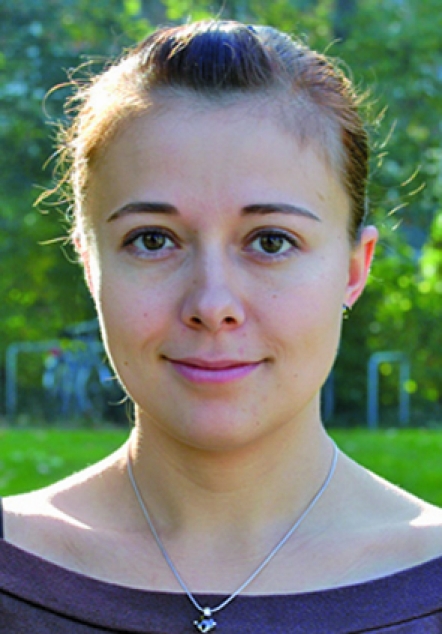
Natalia Bolender
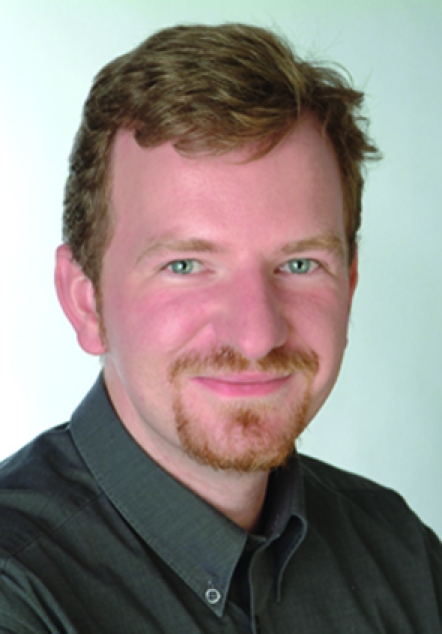
Albert Sickmann
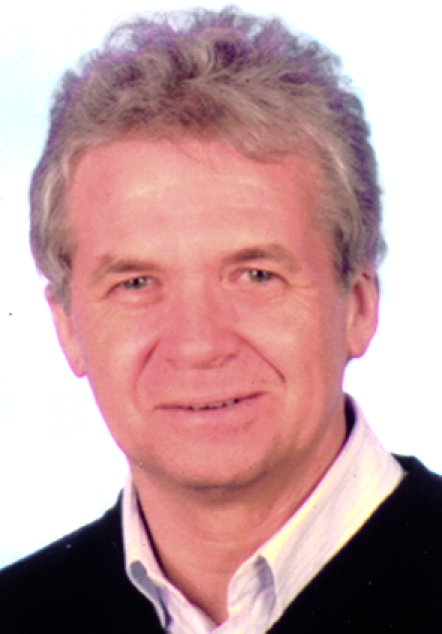
Richard Wagner

Chris Meisinger

Nikolaus Pfanner
Acknowledgments
The authors are supported by the Deutsche Forschungsgemeinschaft, Gottfried Wilhelm Leibniz Program, Max Planck Research Award and Fonds der Chemischen Industrie.
References
- Abe Y, Shodai T, Muto T, Mihara K, Torii H, Nishikawa S-I, Endo T, Kohda D (2000) Structural basis of presequence recognition by the mitochondrial protein import receptor Tom20. Cell 100: 551–560 [DOI] [PubMed] [Google Scholar]
- Albrecht R, Rehling P, Chacinska A, Brix J, Cadamuro SA, Volkmer R, Guiard B, Pfanner N, Zeth K (2006) The Tim21 binding domain connects the preprotein translocases of both mitochondrial membranes. EMBO Rep 7: 1233–1238 [DOI] [PMC free article] [PubMed] [Google Scholar]
- Allen S, Balabanidou V, Sideris DP, Lisowsky T, Tokatlidis K (2005) Erv1 mediates the Mia40-dependent protein import pathway and provides a functional link to the respiratory chain by shuttling electrons to cytochrome c. J Mol Biol 353: 937–944 [DOI] [PubMed] [Google Scholar]
- Becker L et al. (2005) Preprotein translocase of the outer mitochondrial membrane: reconstituted Tom40 forms a characteristic TOM pore. J Mol Biol 353: 1011–1020 [DOI] [PubMed] [Google Scholar]
- Chacinska A et al. (2004) Essential role of Mia40 in import and assembly of mitochondrial intermembrane space proteins. EMBO J 23: 3735–3746 [DOI] [PMC free article] [PubMed] [Google Scholar]
- Chacinska A et al. (2005) Mitochondrial presequence translocase: switching between TOM tethering and motor recruitment involves Tim21 and Tim17. Cell 120: 817–829 [DOI] [PubMed] [Google Scholar]
- Curran SP, Leuenberger D, Oppliger W, Koehler CM (2002) The Tim9p–Tim10p complex binds to the transmembrane domains of the ADP/ATP carrier. EMBO J 21: 942–953 [DOI] [PMC free article] [PubMed] [Google Scholar]
- Curran SP, Leuenberger D, Leverich EP, Hwang DK, Beverly KN, Koehler CM (2004) The role of Hot13p and redox chemistry in the mitochondrial TIM22 import pathway. J Biol Chem 279: 43744–43751 [DOI] [PubMed] [Google Scholar]
- Davis AJ, Alder NN, Jensen RE, Johnson AE (2007) The Tim9p–10p and Tim8p–13p complexes bind to specific sites on Tim23p during mitochondrial protein import. Mol Biol Cell 18: 475–486 [DOI] [PMC free article] [PubMed] [Google Scholar]
- Dimmer KS, Jakobs S, Vogel F, Altmann K, Westermann B (2005) Mdm31 and Mdm32 are inner membrane proteins required for maintenance of mitochondrial shape and stability of mitochondrial DNA nucleoids in yeast. J Cell Biol 168: 103–115 [DOI] [PMC free article] [PubMed] [Google Scholar]
- D'Silva PR, Schilke B, Walter W, Craig EA (2005) Role of Pam16's degenerate J domain in protein import across the mitochondrial inner membrane. Proc Natl Acad Sci USA 102: 12419–12424 [DOI] [PMC free article] [PubMed] [Google Scholar]
- Geissler A, Rassow J, Pfanner N, Voos W (2001) Mitochondrial import driving forces: enhanced trapping by matrix Hsp70 stimulates translocation and reduces the membrane potential dependence of loosely folded preproteins. Mol Cell Biol 21: 7097–7104 [DOI] [PMC free article] [PubMed] [Google Scholar]
- Geissler A et al. (2002) The mitochondrial presequence translocase: an essential role of Tim50 in directing preproteins to the import channel. Cell 111: 507–518 [DOI] [PubMed] [Google Scholar]
- Gentle I, Gabriel K, Beech P, Waller R, Lithgow T (2004) The Omp85 family of proteins is essential for outer membrane biogenesis in mitochondria and bacteria. J Cell Biol 164: 19–24 [DOI] [PMC free article] [PubMed] [Google Scholar]
- Hoppins SC, Nargang FE (2004) The Tim8–Tim13 complex of Neurospora crassa functions in the assembly of proteins into both mitochondrial membranes. J Biol Chem 279: 12396–12405 [DOI] [PubMed] [Google Scholar]
- Ishikawa D, Yamamoto H, Tamura Y, Moritoh K, Endo T (2004) Two novel proteins in the mitochondrial outer membrane mediate β-barrel protein assembly. J Cell Biol 166: 621–627 [DOI] [PMC free article] [PubMed] [Google Scholar]
- Kozjak V, Wiedemann N, Milenkovic D, Lohaus C, Meyer HE, Guiard B, Meisinger C, Pfanner N (2003) An essential role of Sam50 in the protein sorting and assembly machinery of the mitochondrial outer membrane. J Biol Chem 278: 48520–48523 [DOI] [PubMed] [Google Scholar]
- Krayl M, Lim JH, Martin F, Guiard B, Voos W (2007) A cooperative action of the ATP-dependent import motor complex and the inner membrane potential drives mitochondrial preprotein import. Mol Cell Biol 27: 411–425 [DOI] [PMC free article] [PubMed] [Google Scholar]
- Lange H, Lisowsky T, Gerber J, Mühlenhoff U, Kispal G, Lill R (2001) An essential function of the mitochondrial sulfhydryl oxidase Erv1p/ALR in the maturation of cytosolic Fe/S proteins. EMBO Rep 2: 715–720 [DOI] [PMC free article] [PubMed] [Google Scholar]
- Li Y, Dudek J, Guiard B, Pfanner N, Rehling P, Voos W (2004) The presequence translocase-associated protein import motor of mitochondria: Pam16 functions in an antagonistic manner to Pam18. J Biol Chem 279: 38047–38054 [DOI] [PubMed] [Google Scholar]
- Meinecke M et al. (2006) Tim50 maintains the permeability barrier of the mitochondrial inner membrane. Science 312: 1523–1526 [DOI] [PubMed] [Google Scholar]
- Meisinger C et al. (2004) The mitochondrial morphology protein Mdm10 functions in assembly of the preprotein translocase of the outer membrane. Dev Cell 7: 61–71 [DOI] [PubMed] [Google Scholar]
- Meisinger C et al. (2007) The morphology proteins Mdm12/Mmm1 function in the major β-barrel assembly pathway of mitochondria. EMBO J 26: 2229–2239 [DOI] [PMC free article] [PubMed] [Google Scholar]
- Mesecke N, Terziyska N, Kozany C, Baumann F, Neupert W, Hell K, Herrmann JM (2005) A disulfide relay system in the intermembrane space of mitochondria that mediates protein import. Cell 121: 1059–1069 [DOI] [PubMed] [Google Scholar]
- Milenkovic D, Gabriel K, Guiard B, Schulze-Specking A, Pfanner N, Chacinska A (2007) Biogenesis of the essential Tim9–Tim10 chaperone complex of mitochondria: site-specific recognition of cysteine residues by the intermembrane space receptor Mia40. J Biol Chem 282: 22472–22480 [DOI] [PubMed] [Google Scholar]
- Model K, Meisinger C, Prinz T, Wiedemann N, Truscott KN, Pfanner N, Ryan MT (2001) Multistep assembly of the protein import channel of the mitochondrial outer membrane. Nat Struct Biol 8: 361–370 [DOI] [PubMed] [Google Scholar]
- Mokranjac D, Bourenkov G, Hell K, Neupert W, Groll M (2006) Structure and function of Tim14 and Tim16, the J and J-like components of the mitochondrial protein import motor. EMBO J 25: 4675–4685 [DOI] [PMC free article] [PubMed] [Google Scholar]
- Naoé M, Ohwa Y, Ishikawa D, Ohshima C, Nishikawa S, Yamamoto H, Endo T (2004) Identification of Tim40 that mediates protein sorting to the mitochondrial intermembrane space. J Biol Chem 279: 47815–47821 [DOI] [PubMed] [Google Scholar]
- Okamoto K, Brinker A, Paschen SA, Moarefi I, Hayer-Hartl M, Neupert W, Brunner M (2002) The protein import motor of mitochondria: a targeted molecular ratchet driving unfolding and translocation. EMBO J 21: 3659–3671 [DOI] [PMC free article] [PubMed] [Google Scholar]
- Paschen SA, Waizenegger T, Stan T, Preuss M, Cyrklaff M, Hell K, Rapaport D, Neupert W (2003) Evolutionary conservation of biogenesis of β-barrel membrane proteins. Nature 426: 862–866 [DOI] [PubMed] [Google Scholar]
- Prokisch H et al. (2004) Integrative analysis of the mitochondrial proteome in yeast. PLoS Biol 2: e160. [DOI] [PMC free article] [PubMed] [Google Scholar]
- Rehling P et al. (2003) Protein insertion into the mitochondrial inner membrane by a twin-pore translocase. Science 299: 1747–1751 [DOI] [PubMed] [Google Scholar]
- Reinders J, Zahedi RP, Pfanner N, Meisinger C, Sickmann A (2006) Toward the complete yeast mitochondrial proteome: multidimensional separation techniques for mitochondrial proteomics. J Proteome Res 5: 1543–1554 [DOI] [PubMed] [Google Scholar]
- Rissler M, Wiedemann N, Pfannschmidt S, Gabriel K, Guiard B, Pfanner N, Chacinska A (2005) The essential mitochondrial protein Erv1 cooperates with Mia40 in biogenesis of intermembrane space proteins. J Mol Biol 353: 485–492 [DOI] [PubMed] [Google Scholar]
- Sato T, Esaki M, Fernandez JM, Endo T (2005) Comparison of the protein-unfolding pathways between mitochondrial protein import and atomic-force microscopy measurements. Proc Natl Acad Sci USA 102: 17999–18004 [DOI] [PMC free article] [PubMed] [Google Scholar]
- Schleiff E, Soll J (2005) Membrane protein insertion: mixing eukaryotic and prokaryotic concepts. EMBO Rep 6: 1023–1027 [DOI] [PMC free article] [PubMed] [Google Scholar]
- Setoguchi K, Otera H, Mihara K (2006) Cytosolic factor- and TOM-independent import of C-tail-anchored mitochondrial outer membrane proteins. EMBO J 25: 5635–5647 [DOI] [PMC free article] [PubMed] [Google Scholar]
- Shariff K, Ghosal S, Matouschek A (2004) The force exerted by the membrane potential during protein import into the mitochondrial matrix. Biophys J 86: 3647–3652 [DOI] [PMC free article] [PubMed] [Google Scholar]
- Sickmann A et al. (2003) The proteome of Saccharomyces cerevisiae mitochondria. Proc Natl Acad Sci USA 100: 13207–13212 [DOI] [PMC free article] [PubMed] [Google Scholar]
- Sideris DP, Tokatlidis K (2007) Oxidative folding of small Tims is mediated by site-specific docking onto Mia40 in the mitochondrial intermembrane space. Mol Microbiol 65: 1360–1370 [DOI] [PubMed] [Google Scholar]
- Truscott KN, Kovermann P, Geissler A, Merlin A, Meijer M, Driessen AJ, Rassow J, Pfanner N, Wagner R (2001) A presequence- and voltage-sensitive channel of the mitochondrial preprotein translocase formed by Tim23. Nat Struct Biol 8: 1074–1082 [DOI] [PubMed] [Google Scholar]
- van der Laan M et al. (2005) Pam17 is required for architecture and translocation activity of the mitochondrial protein import motor. Mol Cell Biol 25: 7449–7458 [DOI] [PMC free article] [PubMed] [Google Scholar]
- van der Laan M, Wiedemann N, Mick DU, Guiard B, Rehling P, Pfanner N (2006) A role for Tim21 in membrane-potential-dependent preprotein sorting in mitochondria. Curr Biol 16: 2271–2276 [DOI] [PubMed] [Google Scholar]
- Vial S, Lu H, Allen S, Savory P, Thornton D, Sheehan J, Tokatlidis K (2002) Assembly of Tim9 and Tim10 into a functional chaperone. J Biol Chem 277: 36100–36108 [DOI] [PubMed] [Google Scholar]
- Webb CT, Gorman MA, Lazarou M, Ryan MT, Gulbis JM (2006) Crystal structure of the mitochondrial chaperone TIM9–10 reveals a six-bladed α-propeller. Mol Cell 21: 123–133 [DOI] [PubMed] [Google Scholar]
- Wiedemann N, Pfanner N, Ryan MT (2001) The three modules of ADP/ATP carrier cooperate in receptor recruitment and translocation into mitochondria. EMBO J 20: 951–960 [DOI] [PMC free article] [PubMed] [Google Scholar]
- Wiedemann N, Kozjak V, Chacinska A, Schönfisch B, Rospert S, Ryan MT, Pfanner N, Meisinger C (2003) Machinery for protein sorting and assembly in the mitochondrial outer membrane. Nature 424: 565–571 [DOI] [PubMed] [Google Scholar]
- Wiedemann N, Truscott KN, Pfannschmidt S, Guiard B, Meisinger C, Pfanner N (2004) Biogenesis of the protein import channel Tom40 of the mitochondrial outer membrane: intermembrane space components are involved in an early stage of the assembly pathway. J Biol Chem 279: 18188–18194 [DOI] [PubMed] [Google Scholar]
- Yamamoto H, Esaki M, Kanamori T, Tamura Y, Nishikawa S, Endo T (2002) Tim50 is a subunit of the TIM23 complex that links protein translocation across the outer and inner mitochondrial membranes. Cell 111: 519–528 [DOI] [PubMed] [Google Scholar]
- Young JC, Hoogenraad NJ, Hartl FU (2003) Molecular chaperones Hsp90 and Hsp70 deliver preproteins to the mitochondrial import receptor Tom70. Cell 112: 41–50 [DOI] [PubMed] [Google Scholar]
- Youngman MJ, Hobbs AE, Burgess SM, Srinivasan M, Jensen RE (2004) Mmm2p, a mitochondrial outer membrane protein required for yeast mitochondrial shape and maintenance of mtDNA nucleoids. J Cell Biol 164: 677–688 [DOI] [PMC free article] [PubMed] [Google Scholar]



